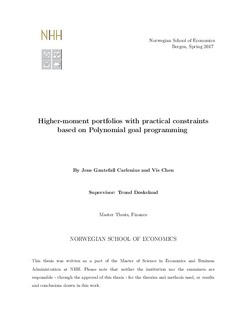Higher-moment portfolios with practical constraints based on Polynomial goal programming
Master thesis
Permanent lenke
http://hdl.handle.net/11250/2453527Utgivelsesdato
2017Metadata
Vis full innførselSamlinger
- Master Thesis [4372]
Sammendrag
This thesis contributes to the field of portfolio selection by constructing and analyzing the
impact of incorporating higher-moments by Polynomial goal programming. We construct
the mean-variance-skewness and the mean-variance-skewness-kurtosis portfolio over a 20-year
horizon using 29 stocks from the S&P Global 1200-index. We examine the performance of
higher-moment portfolios in terms of return, risk and allocation, compared to two benchmark
portfolios; the traditional Markowitz portfolio and the global minimum variance portfolio.
Our findings suggest that an investor obtains a higher return and risk-adjusted return by
incorporating skewness into the mean-variance allocation framework. The mean-varianceskewness
portfolio can further be improved by a diversification constraint as a result of the
portfolio’s occasional concentrated allocations, while limiting turnover turns out to be relatively
detrimental for its performance. The results are less clear when both skewness and kurtosis
are incorporated into the asset allocation framework, as the mean-variance-skewness-kurtosis
portfolio is outperformed by the benchmark portfolios unless a turnover or a strong diversification
constraint is imposed. In general we find that higher-moment portfolios obtain more optimal
out-of-sample higher-moments at the cost of higher out-of-sample variance. The differences
between the out-of-sample moments are augmented by rebalancing the portfolios or by imposing
the strong diversification constraint.
